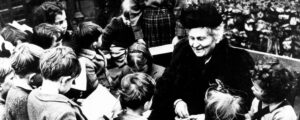Philosophy
THE MONTESSORI PHILOSOPHY

“The secret of good teaching is to regard the child’s intelligence as a fertile field in which seeds may be sown, to grow under the heating flame of imagination. Our aim is to not only make the child understand, and still less force him to memorize, but so to touch his imagination as to enthuse him to his innermost core. We do not want complacent pupils but eager ones. We seek to sow life in the child rather than theories to help him in his growth, mental and emotional as well as physical and for that we must offer grand and lofty ideas to the human mind.”
Maria Montessori
(August 31, 1870 – May 6, 1952) was an Italian physician, educator, philosopher and humanitarian; she is best known for her philosophy and method of education of children from birth to adolescence. Her educational method is in use today in a number of public as well as private schools throughout the world.
Dr. Montessori felt that the goal of the educational process should not be to fill the child with facts but rather to cultivate the child’s own natural desire to learn.Children between the ages of three and six can pick up knowledge and understanding effortlessly, spontaneously and joyfully. Dr. Montessori called the child’s mind at this stage “absorbent” and discovered that during these years there are sensitive periods when the child shows an unusual ability to acquire particular skills compared to any other time in his life.
Dr. Montessori’s research indicated that children have fantastic powers of concentration if properly stimulated, far exceeding that of most adults. Children would rather work than play when given a choice between toys and stimulating work. Montessori educators have a responsibility to train children’s characters to achieve self-discipline and self-direction which result from the mastery of firsthand experience and fulfillment of the inner urge to expand and grow in one’s own way. This growth is achieved without jeopardizing the rights of others to have this same privilege.
The Montessori Classroom
Classroom environments in Montessori education are prepared by scaling to a child’s size and gearing to his or her inner needs, allowing the child to learn by his or her own choice and at his or her own pace. Believing that children are best able to comprehend their environment in very concrete, hands-on ways and through immediate personal contact, Dr. Montessori designed materials to lead the child toward the ability to work in abstractions in numbers, letters and ideas. These materials are meant only as a means to an end and are to be relied upon less as the child becomes increasingly more able to work with abstractions. Feeling that there is an important correlation between muscular activity and learning, Montessori incorporated movement into the use of the equipment, which includes error-control factors that the child can understand without having to be told.
Dr. Montessori’s insights into the inner needs and workings of children led to her respect for their initiative and ability and her expectation that they will naturally do what is right without being forced, resulting from direct observation of children in actual classroom situations. Through observation of a Montessori class in action, one can understand the secret of her success.
The Montessori Method
The Montessori Method is a child-centered educational approach based on scientific observations of children from birth to adulthood, according to the American Montessori Society. Multiage groupings that foster peer learning, uninterrupted blocks of work time, and guided choice of work activity are just a few of the components that make up an authentic Montessori method of education. Dr. Montessori’s Method has been time tested, with over 100 years of success in diverse cultures throughout the world.
Montessori-based learning refers to the use and creation of the hands, which instruct the intelligence. Through their work, the children develop a general foundation that includes a positive attitude, inner security and a sense of order, pride in the physical environment, abiding curiosity, a habit of concentration, joyful self-discipline, habits of initiative and persistence, the ability to make decisions, and a sense of responsibility to the group.
The teacher serves as an enthusiastic guide in the child’s progress from simple to complex, rudimentary to refined, outer to self-control. Next to learning from one’s own experience, the child learns best from other children. Therefore, children are grouped in three-year age groups to give children a series of models for imitation and older children the opportunity to reinforce their own knowledge by helping younger children. Competition has no place in Montessori education until after the child has gained confidence in his or her own abilities.
